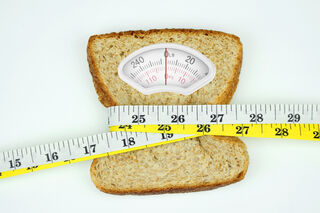Diet
An Easier Way to Lose Weight: A Personal Story
How I tailored the experts' advice so that it worked for me.
Posted January 30, 2022 Reviewed by Abigail Fagan
Key points
- Cutting calories by modifying what I normally ate was much easier than trying to stick to a diet that was radically different.
- The likelihood of long-term success increased when I applied scientific and expert advice in a way that was easiest for me.
- Because habits resist change and the body resists rapid weight loss, aiming for slow, steady progress makes the most sense.

Experts agree on how best to achieve long-term weight loss. They advise not dieting, avoiding triggers (hunger, a sense of deprivation, and irresistible foods) and exchanging good for bad eating habits. But how do we each go about enacting this advice? Here is the way I did it.
In a previous post, I explained my personal hurdles and solutions. Because my husband and I need the reward of periodically eating without restraint, we made a deal with ourselves not to outlaw indulgence but to limit it to weekends, eating leaner on weekdays. This is a follow-up post on specifics: how we changed our eating habits through food trades and how I get my sedentary self to exercise. I hope it will suggest a path to your own personal solutions.
How to start
In the hunt for calories to cut, I started by swapping, for a low-cal version, one high-calorie food I ate every day: a breakfast cereal so delicious I couldn’t resist snacking on it. When the box was empty, I replaced it with a high-fiber alternative (i.e. not just crunchy air). I didn’t much like it at first—but I added fresh berries. Otherwise, breakfast and lunch stayed the same.
Recent studies support this simple approach: The best way to break a bad habit (my sugar-laden cereal) is to add (the berries), not just subtract (my addictive cereal), and to replace the bad habit with a better one, simultaneously (the swap repeated daily).
The time it takes to substitute one habit for another, according to the most oft-quoted study, varies from 18 to 254 days. I got used to my cereal switch in under a month, eating it six times a week. I don’t count calories, but just to give you an idea, the daily saving between the two cereals (+ berries) is 95 calories, or 570/week: an 8-pound weight loss over a year from this one exchange. You might swap an orange for a glass of OJ (75 calories), an English muffin for a donut (75 calories), or a slice of toast for a donut (150 calories).
To avoid the trigger of hunger, our low-cal weekday dinners have to be filling, which means heavy on salad and vegetables, so I hunted out a low-fat salad dressing and a method of making vegetables truly delicious, eventually learning to pan roast them at a high heat with a little olive oil and salt. On weekdays, my husband and I eat the least caloric proteins, chicken, and fish. Fruit for dessert. No bread or snacks, because once I start I can’t stop.
But we do this only four nights a week. From Friday dinner through Sunday dinner, we eat whatever we want, just making sure there are no tempting leftovers when Monday rolls around.
The best trade is whichever is easiest. I have a friend who lost 10 pounds with two small exchanges: switching an after-work scotch for a glass of white wine and his daily sandwich for a salad.
Because vacations and holidays are always one long blowout, occasionally we have to go lean on a weekend. Then, I make low-cal meals that are special in another way, something we'd never eat midweek, like lean red meat or seafood. The object is to not feel cheated.
I'd much rather get to my goal more slowly than risk activating cravings that would pitch me off the rails altogether. One friend, after a bout of severe calorie-cutting, swallowed a single tablespoon of grapefruit juice to kill the bad taste in his mouth, turned instantly ravenous, and rapidly undid his weeks of dieting.
What about exercise?
Of course, to lose weight (let alone get fit) you need to exercise. Finding an enticement wasn’t easy: I’m not sportive and hate sweating. When I was younger I jogged, but I’d start out strong and steadily slow down until I was strolling. I could only make jogging a routine if I did it with a friend; when she dropped out, I’d quit.
Enter the treadmill, which has the brilliant advantage of removing volition from walking. Essentially, it walks you. With a small TV mounted in front and earphones, I can watch a film while walking. In the dark, with the movie audio drowning out the treadmill, I forget where I am. I slowly inch up the speed but only so long as I can remain lost in the film. With thrillers, I can speed up even more without noticing. I’m quite fast now, but I got there over years, not weeks.
Clearly, a treadmill isn’t practical for everyone, but could listening to mysteries on tape work for you? Could a jazz dance class or group mall walk? One friend who worked in a high-rise ended the day by climbing the stairs to the roof, descending to the lobby, and climbing back up to the office—with her boss (not that it was fun). Still, the right partner can be key.
In the last decade, I’ve begun working out. My husband broke his hip and had to do physical therapy, which mutated into working with a trainer. He humiliated me into joining him, and I stick with it, because getting strong keeps you young. Making progress turns out to be a hook. I can barely believe I am writing this, but training has also become a habit.
Improved health is usually promoted as the best long-term goal; personally, I'm driven by vanity. I used to have two wardrobes, a "fat" and "thin" one, and I remember vividly the very few moments in my old life when the thin one got any wear. Of course, there are many benefits to being fit: It’s empowering; your PCP will love you; you can run up the subway stairs to catch the train. But feeling good about your body is no small thing. We shouldn’t knock it.
And finally, I tweak. Tastes change and metabolisms speed up as muscles grow. Plus, with any weight-loss plan, there are plateaus when the body adjusts to its lower weight and establishes a new set-point that it will then work to maintain. (This is actually a good thing, as any quick weight gain above the set-point is quickly lost.) I may have to up my exercise or cut back on indulgences for a few weeks if I want to lower my set-point further. But if I'm committed for the long haul, speed is not my friend. I have to be patient with my body; we're in this together.
References
Lally, van Jaarsveld, Potts, Wardle (2009). How habits are formed: Modeling habit formation in the real world. University College London, EJSP.




